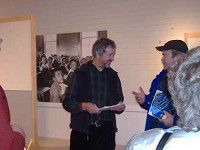‘The Orphan Tsunami of 1700’
Published 4:00 pm Tuesday, March 21, 2006

- <I>PHIL RAISTAKKA photo</I><BR>Geologist Brian Atwater chats with an area resident following a presentation in Skamokawa.
SKAMOKAWA – The book, “The Orphan Tsunami of 1700” is a must-read for residents of the Pacific Northwest, especially for those of us who live near the Pacific Ocean, or west of the Cascade Mountains, for that matter.
Two of the co-authors and researchers for the book, Brian F. Atwater and David K. Yamaguchi, presented an overview of the research which led to the publication of the book in 2005, at Redmen Hall in Skamokawa on Sunday, March 12.
Atwater, a geologist with the United States Geological Survey, and Yamaguchi, who was a forester and data analyst on a fellowship with the U.S. Geological Survey at the time of the book’s conception, presented the events and data that enabled them to collaborate with four Japanese researchers in the writing of the book.
It was Atwater, whose 30-year career with the U.S. Geological Survey has included extensive work on earthquakes in the United States, Chile and Japan, who conceived of the book and led to its preparation. Atwater’s work has included extensive field research in the bays, estuaries and rivers in the coastal regions of Washington, Oregon and California.
Yamaguchi, a Seattle-born grandson of Japanese immigrants, has done extensive work on tree-ring growth studies, especially as identified in the trees from the Mt. St. Helen’s eruptions of 1479-82. Those findings led to a fellowship with the U.S. Geological Survey. During that fellowship, he began the coastal tree-ring studies that helped to identify the source of the orphan tsunami of 1700. He also served as visiting scholar at the Forestry and Forest Products Research Institute in Hokkaido, Japan.
During their nearly two-hour presentation in Skamokawa, Yamaguchi presented tree core samples taken from trees felled on Willapa Bay’s Long Island during logging operations in the late 1980s. He was able to compare those rings taken from the trees felled on a definite date to samples taken from cedar snags and spruce stump roots that were killed, and some buried, during the 1700 earthquake.
In the early 1700s, the Pacific Northwest was largely a blank spot on the map, while in Japan extensive records had been kept of many events, including an unusually high sea that had come ashore in 1700, wreaking havoc. People who recorded the event had felt no earthquake and they called it a high tide rather than a tsunami. They had no way of knowing that a seismic shift on a North American fault had set off a chain of cross-Pacific waves.
The source of the Japan tsunami would remain unknown until the last decade of the 20th century, nearly 300 years after it occurred. That is when the work of Atwater, Yamaguchi, and others on this side of the Pacific would identify the seismic shift that produced the tsunami of 1700. Collaboration with the Japanese researchers, and documentation kept in Japanese records, were able to pinpoint a date of January 26, 1700, for the event. The earthquake was an estimated magnitude of 8.7 to 9.2.
One has only to compare the magnitude of that earthquake with the size of more recently recorded earthquakes to make a vivid comparison. As examples, the Good Friday 1964 Alaska earthquake was 9.2 in size while the devastating Indian Ocean tsunami on Dec. 26, 2004, was created by an earthquake with a magnitude of 9.0.
The authors, after documenting the events of the tsunami of 1700 as it occurred here in the Northwest and reached all the way to Japan, give some ideas of what can be expected the next time that such a seismic event occurs in the area known as Cascadia. Cascadia is defined as the region west of the Cascade Range from southern British Columbia to northern California.
The book points out that Cascadia is the location of two of the moving tectonic plates that make up the earth’s outer shell. The offshore part of that boundary is the fault that ruptured in 1700.
The authors ask the question, “What losses will Cascadia sustain the next time it breaks?” They then proceed to provide some answers to that question as they document events that happened here in the Pacific Northwest as well as those events that occurred in Japan with the “orphan tsunami.”
They point out that a whole series of calamitous events are very likely to occur here in the western portions of Washington and Oregon the next time that such an event occurs. They point out some of the precautions that must take place in order to survive such an event.
Brian Atwater, and perhaps David Yamaguchi, will present the findings of the book “The Orphan Tsunami of 1700” at FinnFest USA ’06. Atwater is tentatively scheduled to present this topic at the Naselle School at 8:30 a.m. Saturday, July 29.




